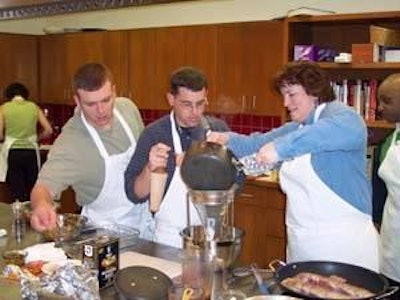
You can follow your nose to the kitchen in the John W. Tyson building on the University of Arkansas campus if it is afternoon and a culinary arts class is scheduled for that week. The smells permeate the building, especially if bread is baking or meat is grilling. Two long tables in the hallway outside the kitchen are filling with platters and show plates of today's production. If you peek in, you will be amazed at how many people are in the kitchen and you can quickly tell these are not college students.
Learning culinology
The people scurrying around the kitchen are product developers, most with advanced degrees and many years of product development experience. They are cooking to learn and understand the cooking process so that they can perform their product development tasks better. Some are doing it solely for professional development but most are doing it as part of a Research Chefs Association certification program. RCA is the professional community for food research and product development and the originators and practitioners of Culinology the blending of culinary arts and food technology.
Formed in 1996, RCA has worked with universities and colleges to develop 10 culinology degree programs that are now producing graduates with the equivalent of a B.S. in food science and a two-year culinary arts degree.
Two certification programs are offered by RCA, certified research chef and certified culinary scientist. The CRC validates culinary arts education, food service work experience, at least three years' work experience in product development and a baseline knowledge of food science through an exam, while the CCS validates food science education, baseline culinary arts experience, at least three years work experience in product development and a baseline knowledge of culinary arts through an exam.
Product developers seeking the CCS designation can meet their culinary experience in three ways: pass the American Culinary Federation-certified culinarian practical exam, spend one year cooking full-time in a commercial kitchen or put in 120 hours of hands-on culinary coursework. Most people opt for the 120 contact hours in a hands-on culinary course and this is what the University of Arkansas offers. But that is still three weeks at the University of Arkansas or four weeks at some other institution.
Every kind of cooking
These product developers are experiencing and learning by instruction and demonstration but primarily by cooking. The group will make breakfast four of five days and lunch every day. As groups they will make all five of the mother sauces -- hollandaise, bechamel, veloute, tomato and espagnole. They will experience first-hand every one of the 14 forms of cooking (bake, roast, grill, broil, saute, stir-fry, pan fry, deep fry, poach, simmer, boil, steam, braise and stew). During the three weeks they will cook with a wide assortment of meat, poultry, seafood, vegetables, grains, potatoes, fruits and cheese. Students learn how to bake breads, biscuits, cakes, pies and cookies. They also make appetizers, soups, salads, salad dressings, sandwiches, side dishes, entrees, sauces and desserts. Students even make sausage, pate and cured meat.
It's also about learning the language
Culinary art has its own vocabulary, and this is as much part of what product developers need to know as anything else. When they are done, they should know what tomato concassee means and how to make it. Students learn to cut a bell pepper in brunoise for garnish and assemble a bouquet garni to go with the mirepoix for making veal stock which will eventually become demi-glace. Translated, this means that they can peel, de-seed and dice fresh tomato, cut bell pepper into very small pieces of 1/8 inch on each side and tie together leek, parsley stems and bay leaf with string and put it along with onion, carrot and celery in a pot with roasted veal bones to make a stock that will eventually be highly reduced and thickened to make a very rich brown sauce that can be used by itself or become a base for other sauces.
Learning and understanding the culinary terms and processes is a vital part of practising culinology. Most, if not all, product developers will be working with chefs, either in their own company or from customers or suppliers. It is important for them to understand and be able to communicate with the chefs with as few barriers to effective communication as possible. As chefs, marketing or product development teams come up with new product ideas or "gold standard" recipes, it will fall to the product developer to take that recipe from the test kitchen to the manufacturing floor and get as good a product as possible with the appropriate cost for the market.
Meeting needs of more demanding consumers
Television has changed the way many people look at food. Today's consumer looks for a gourmet experience with all their food choices. Creating flavor is an important technique that the product developers learn through these culinary classes. There are ways to add layers of flavors in the cooking process that will make the food distinctive and desirable. Toasting or roasting of spices, grilling of vegetables prior to incorporation and using reduction in broths and sauces to concentrate flavor are key lessons learned in these courses.
So far Tyson Foods has 14 associates who have achieved the CCS designation and another 24 who have finished the 120 hours of culinary training and are in the process of preparing for the exam. The ones who have finished can tell you personally that it took work on their part to complete the requirements and that they have a true sense of achievement when finished.
Dr. John Marcy, professor, University of Arkansas, Donna Delozier, his assistant, and Suzie Stephens, certified executive chef, developed the first 40 hours of coursework for Tyson Foods and the program launched in August 2005. Tyson Foods brought in Johnson & Wales University to work with the University of Arkansas for the second and third weeks of their program. The University of Arkansas will conduct three weeks of classes for Tyson Foods and three weeks for RCA in 2009.
In mid-May 2009, the University of Arkansas began another class for 10 Tyson product developers, bringing the number of Tyson associates in various stages of the program since 2005 to 85. In addition to classes for Tyson Foods, the University of Arkansas has worked with RCA to offer classes for product developers from poultry and food companies such as Classic Foods, Lamb Weston, DairiConcepts, Uncle Ben's, McCain Foods, McCormick & Company, National Steak and Poultry, Nestlé, Newly Weds Foods, Pilgrim's Pride, French's and Simmons Foods.















